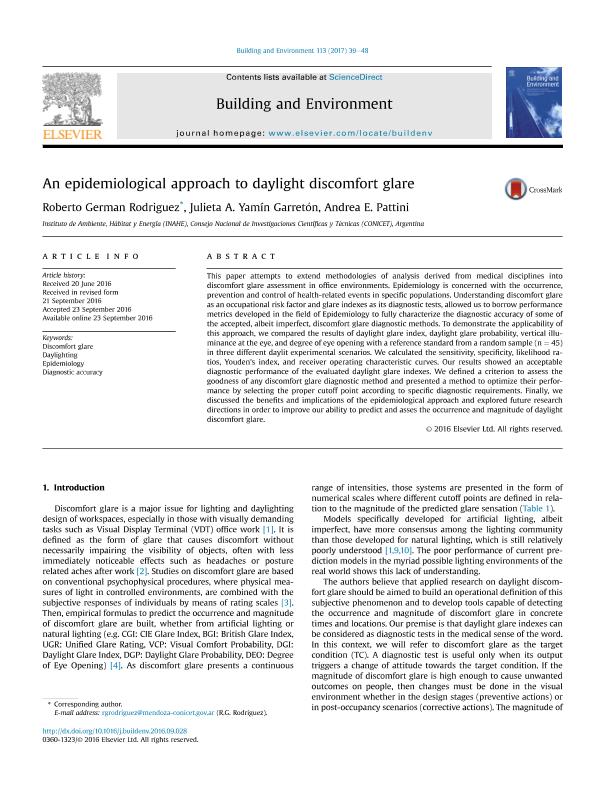Mostrar el registro sencillo del ítem
dc.contributor.author
Rodriguez, Roberto Germán

dc.contributor.author
Yamin Garretón, Julieta Alejandra

dc.contributor.author
Pattini, Andrea Elvira

dc.date.available
2018-03-28T16:57:09Z
dc.date.issued
2017-02
dc.identifier.citation
Rodriguez, Roberto Germán; Yamin Garretón, Julieta Alejandra; Pattini, Andrea Elvira; An epidemiological approach to daylight discomfort glare; Pergamon-Elsevier Science Ltd; Building and Environment; 113; 2-2017; 39-48
dc.identifier.issn
0360-1323
dc.identifier.uri
http://hdl.handle.net/11336/40396
dc.description.abstract
This paper attempts to extend methodologies of analysis derived from medical disciplines into discomfort glare assessment in office environments. Epidemiology is concerned with the occurrence, prevention and control of health-related events in specific populations. Understanding discomfort glare as an occupational risk factor and glare indexes as its diagnostic tests, allowed us to borrow performance metrics developed in the field of Epidemiology to fully characterize the diagnostic accuracy of some of the accepted, albeit imperfect, discomfort glare diagnostic methods. To demonstrate the applicability of this approach, we compared the results of daylight glare index, daylight glare probability, vertical illuminance at the eye, and degree of eye opening with a reference standard from a random sample (n = 45) in three different daylit experimental scenarios. We calculated the sensitivity, specificity, likelihood ratios, Youden's index, and receiver operating characteristic curves. Our results showed an acceptable diagnostic performance of the evaluated daylight glare indexes. We defined a criterion to assess the goodness of any discomfort glare diagnostic method and presented a method to optimize their performance by selecting the proper cutoff point according to specific diagnostic requirements. Finally, we discussed the benefits and implications of the epidemiological approach and explored future research directions in order to improve our ability to predict and asses the occurrence and magnitude of daylight discomfort glare.
dc.format
application/pdf
dc.language.iso
eng
dc.publisher
Pergamon-Elsevier Science Ltd

dc.rights
info:eu-repo/semantics/openAccess
dc.rights.uri
https://creativecommons.org/licenses/by-nc-sa/2.5/ar/
dc.subject
Daylighting
dc.subject
Diagnostic Accuracy
dc.subject
Discomfort Glare
dc.subject
Epidemiology
dc.title
An epidemiological approach to daylight discomfort glare
dc.type
info:eu-repo/semantics/article
dc.type
info:ar-repo/semantics/artículo
dc.type
info:eu-repo/semantics/publishedVersion
dc.date.updated
2018-03-27T13:38:17Z
dc.journal.volume
113
dc.journal.pagination
39-48
dc.journal.pais
Estados Unidos

dc.journal.ciudad
Amsterdam
dc.description.fil
Fil: Rodriguez, Roberto Germán. Consejo Nacional de Investigaciones Científicas y Técnicas. Centro Científico Tecnológico Conicet - Mendoza. Instituto de Ambiente, Hábitat y Energía; Argentina
dc.description.fil
Fil: Yamin Garretón, Julieta Alejandra. Consejo Nacional de Investigaciones Científicas y Técnicas. Centro Científico Tecnológico Conicet - Mendoza. Instituto de Ambiente, Hábitat y Energía; Argentina
dc.description.fil
Fil: Pattini, Andrea Elvira. Consejo Nacional de Investigaciones Científicas y Técnicas. Centro Científico Tecnológico Conicet - Mendoza. Instituto de Ambiente, Hábitat y Energía; Argentina
dc.journal.title
Building and Environment

dc.relation.alternativeid
info:eu-repo/semantics/altIdentifier/doi/http://dx.doi.org/10.1016/j.buildenv.2016.09.028
dc.relation.alternativeid
info:eu-repo/semantics/altIdentifier/url/https://www.sciencedirect.com/science/article/pii/S0360132316303754
Archivos asociados
